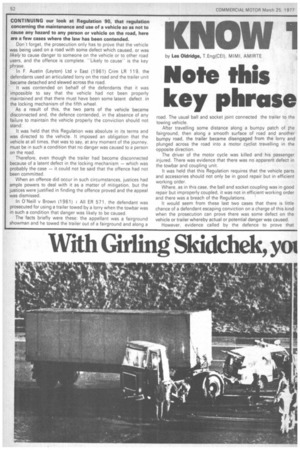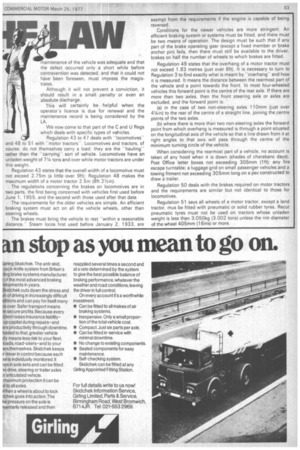OW -1 by Les Oldridge, T Eng(CE1), MIMI, AM1RTE
Page 54

Page 55

If you've noticed an error in this article please click here to report it so we can fix it.
Note this key phrase
CONTINUING our look at Regulation 90, that regulation concerning the maintenance and use of a vehicle so as not to cause any hazard to any person or vehicle on the road, here are a few cases where the law has been contended.
Don't forget, the prosecution only has to prove that the vehicle was being used on a road with some defect which caused, or was likely to cause danger to someone on the vehicle or to other road users, and the offence is complete. "Likely to causeis the key phrase.
In F. Austin (Leyton) Ltd v East (1961) Crim LR 119, the defendants used an articulated lorry on the road and the trailer unit became detached and slewed across the road.
It was contended on behalf of the defendants that it was impossible to say that the vehicle had not been property maintained and that there must have been some latent defect in the locking mechanism of the fifth wheel.
As a result of this, the two parts of the vehicle became disconnected and, the defence contended, in the absence of any failure to maintain the vehicle properly the conviction should not stand.
It was held that this Regulation was absolute in its terms and was directed to the vehicle. It imposed an obligation that the vehicle at all times, that was to say, at any moment of the journey, must be in such a condition that no danger was caused to a person on the road.
Therefore, even though the trailer had become disconnected because of a latent defect in the locking mechanism — which was probably the .case — it could not be said that the offence had not been committed.
When an offence did occur in such circumstances, justices had ample powers to deal with it as a matter of Mitigation, but the justices were justified in finding the offence proved and the appeal was dismissed.
In O'Neill v Brown (1961) I All ER 571, the defendant was prosecuted for using a trailer towed by a lorry when the towbar was in such a condition that danger was likely to be caused.
The facts briefly were these: the appellant was a fairground showman and he towed the trailer out of a fairground and along a _road. The usual ball and socket ]oint connected the trailer to the towing vehicle.
After travelling some distance along a bumpy patch of he fairground, then along a smooth surface of road and another bumpy road, the trailer became disengaged from the lorry and plunged across the road into a motor cyclist travelling in the opposite direction.
The driver of the motor cycle was killed and his _passenger injured. There was evidence that there was no apparent defect in the towbar and coupling unit.
It was held that this Regulation requires that the vehicle parts and accessories should not only be in good repair but in efficient working order.
Where, as in this case, the ball and socket coupling was in good repair but improperly coupled, it was not in efficient working order and there was a breach of the Regulations.
It would seem from these last two cases that there is little chance of a defendant escaping conviction on a charge of this kind when the prosecution can prove there was some defect on the vehicle or trailer whereby actual or potential danger was caused.
However, evidence called by the defence to prove that maintenance of the vehicle was adequate and that the defect occurred only a short while before contravention was detected, and that it could not have been foreseen, must impress the magistrates.
Although it will not prevent a conviction, it should result in a small penalty or even an absolute discharge.
This will certainly be helpful when the operator's licence is due for renewal and the maintenance record is being considered by the LA.
We now come to that part of the C and U Regs which deals with specific types of vehicles.
Regulation 43 to 47 deals with locomotives' ' and 48 to 51 with -motor tractors-. Locomotives and tractors, of course, do not themselves carry a load; they are the haulingrather than the -carryingsort of vehicle. Locomotives have an unladen weight of 71/4 tons and over while motor tractors are under this weight
Regulation 43 states that the overall width of a locomotive must not exceed 2.75m (a little over 9ft); Regulation 48 makes the maximum width of a motor tractor 2.5m (8ft 21/2in).
The regulations concerning the brakes on locomotives are in two parts, the first being concerned with vehicles first used before June 1, 1955, and the second with those used after that date.
The requirements for the older vehicles are simple. An efficient braking system must act on all the vehicle wheels, other than steering wheels.
The brakes must bring the vehicle to rest -within a reasonable distance.Steam locos first used before January 2, 1933, are
exempt from the requirements if the engine is capable of being reversed.
Conditions for the newer vehicles are more stringent. An efficient braking system or systems must be fitted, and there must be two means of operation. The design must be such that if any part of the brake operating gear (except a fixed member or brake anchor pin) fails, then there must still be available to the driver, brakes on half the number of wheels to which brakes are fitted.
Regulation 49 states that the overhang of a motor tractor must not exceed 1.83 metres (just over 6ft). It is necessary to turn to Regulation 3 to find exactly what is meant by "overhangand how it is measured. It means the distance between the rearmost part of the vehicle and a point towards the front. In most four-wheeled vehicles this forward point is the centre of the rear axle. If there are more than two axles, then the front steering axle or axles are excluded, and the forward point is: " (a) in the case of two non-steering axles 110mm(just over 41/4in) to the rear of the centre of a straight line, joining the centre points of the two axles.
(b) where there is more than two non-steering axles the forward point from which overhang is measured is through a point situated on the longitudinal axis of the vehicle so that a line drawn from it at right angles to that axis will pass through the centre of the minimum turning circle of the vehicle.
When considering the rearmost part of a vehicle, no account is taken of any hood when it is down (shades of charabanc days); Post Office letter boxes not exceeding 305mm (1ft); any fire escape turntable; a luggage grid on small passenger vehicles and a towing fitment not exceeding 305mm long on a psv constructed to draw a trailer.
Regulation 50 deals with the brakes required on motor tractors and the requirements are similar but not identical to those for locomotives.
Regulation 51 says all wheels of a motor tractor, except a land tractor, mus be fitted with pneumatic or solid rubber tyres. Recut pneumatic tyres must not be used on tractors whose unladen weight is less than 3.050kg (3.002 tons) unless the rim diameter of the wheel 405mm (16ins) or more.




























































































